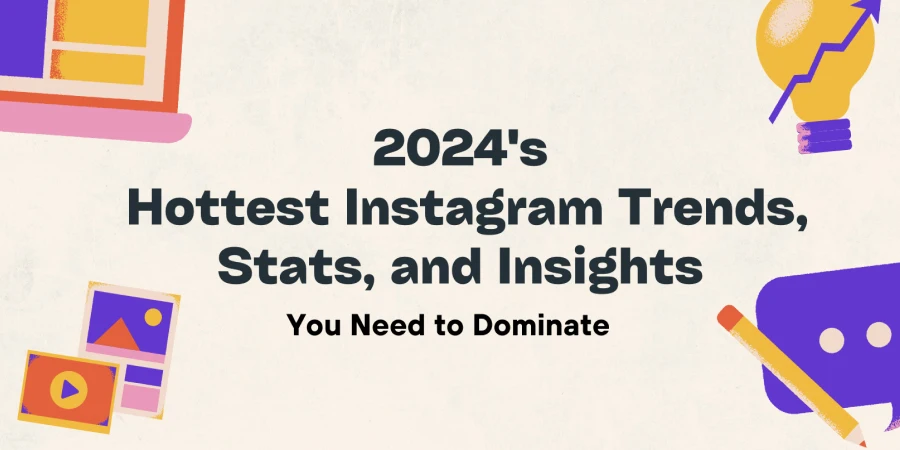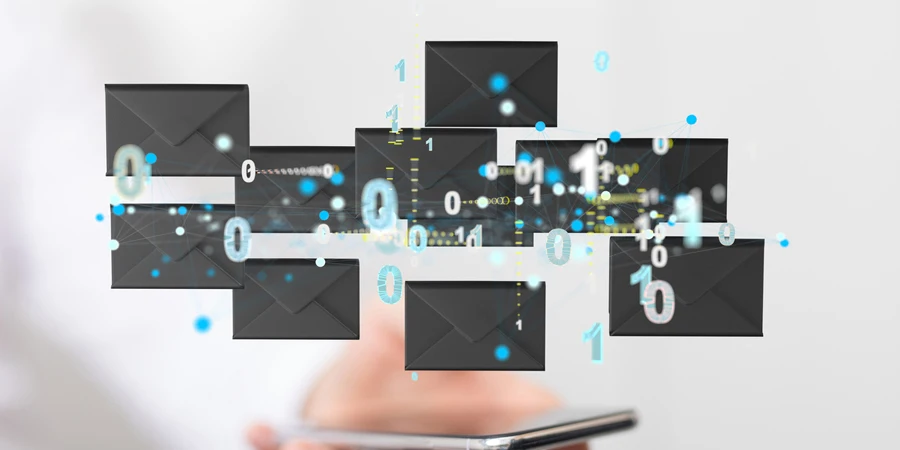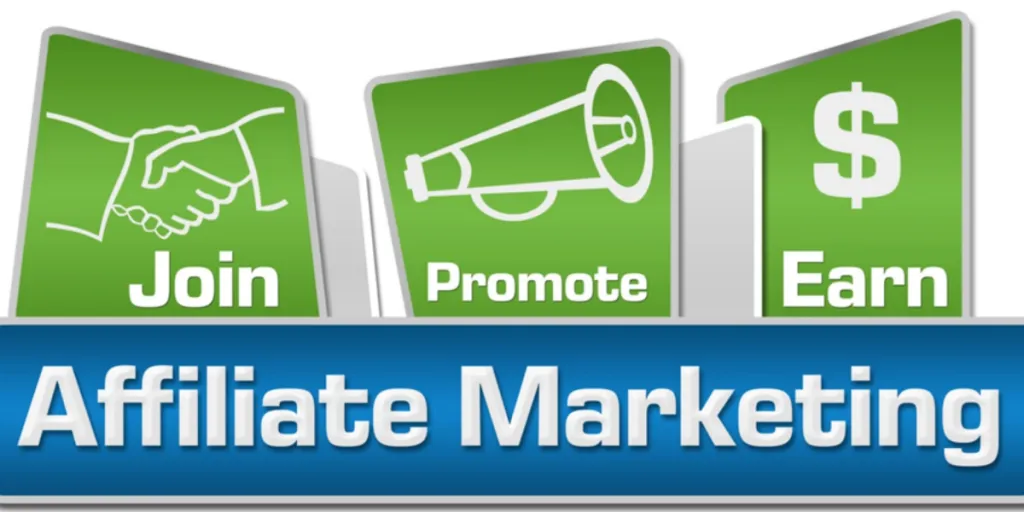Are you looking for reliable email marketing best practices to boost your campaigns? If so, then this post is for you.
While it isn’t over-hyped like the newer marketing channels, email marketing is a reliable classic. It’s effective and among the cheapest marketing channels for lead generation and sales conversions.
However, to get results, you’ll need to do more than build a long contact list and send newsletters. You’ll need to engage subscribers, foster long-term relationships, and turn them into loyal customers.
This post breaks key email marketing best practices into three categories: strategy, content, and design.
Let’s get started.
Email marketing best practices
Table of Contents
1. Activate double opt-in
2. Send emails at the right time
3. Write brief and compelling subject lines
4. Add a preview text
5. Keep email copy short and simple
6. Make irresistible CTA buttons
7. Send welcome emails
8. Educate your subscribers
9. Write captivating stories
10. Use social proof
11. Tailor emails according to subscriber activity
12. Make your subscribers feel appreciated
13. Add social media content and buttons
14. Design simple, scannable emails
15. Be consistent with your campaigns
16. Automate repetitive campaigns
17. Track engagement with clickmaps
18. Add unsubscribe and content preference buttons to footers
19. Use analytics to track email performance
20. Keep your email list clean
21. Monitor deliverability
1. Activate double opt-in
Category: Strategy
Having a double opt-in email marketing strategy keeps your email contact list clean. This strategy involves adding an extra confirmation step for your prospects, which requires their consent to receive emails from you.
Once a site visitor provides their details via your signup form, you send an email asking them to confirm their subscription. It’s only after the confirmation that their email address is added to your list.
A double opt-in is among the top email marketing practices because
- It helps you weed out fake sign-ups or fake emails reducing your bounce rates
- Helps you stay compliant with anti-spam email regulations
- Gives your prospects a chance to confirm or opt out of a subscription
Your opt-in email could be in form of a welcome email giving them the option to stay subscribed or opt-out. Or it could be a simple notification email like the one below.
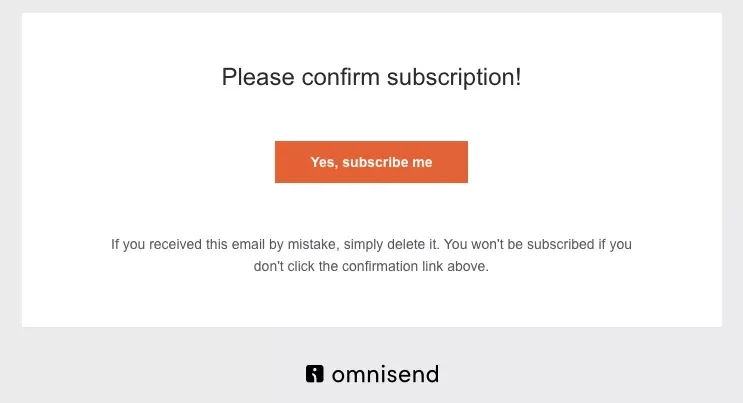
2. Send emails at the right time
Category: Strategy
Scheduling your emails for specific months, days, and times helps increases your open rates, click-through rates, and ultimately, your conversion rates.
How can you find the best times to send emails?
Omnisend conducted research based on data from emails sent over the past three years, between 2019 and 2022. Here are the findings.
- The best time to send emails is 8 pm for the best open rates, and 1 pm or 4-5 pm for the best click-through rates.
Local sending time (24h) vs Clickthrough rate
Omnisend research shows that 5am, 6am, 5pm and 6pm have the best clickthrough rates
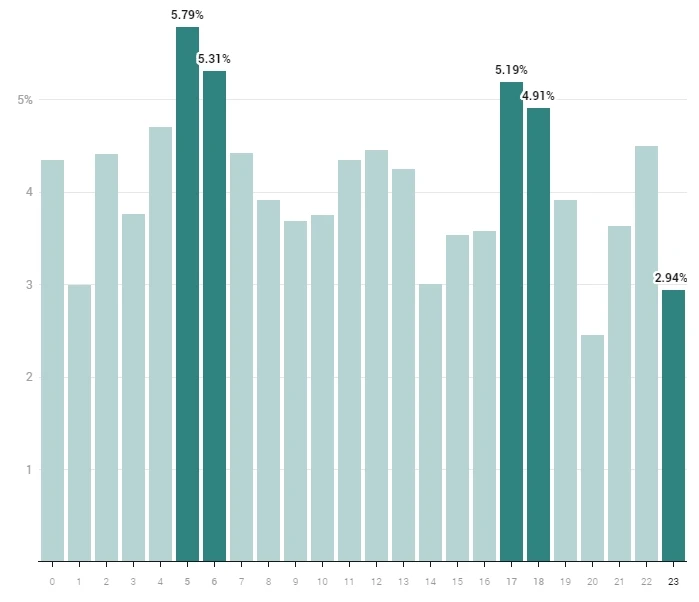
- The best days to send emails are Tuesday to Thursday for high open rates, Friday and Sunday for high click-through rates, and Friday for conversions.
Weekday vs Conversion rates (%)
Omnisend research shows that Fridays have the best average conversion rates (sales vs clicks), while Saturdays have the lowest conversions.

- The best days of the month to send emails are the 10th and 24th for open rates, the 2nd for click rates, and the 1st for the highest conversion rates.
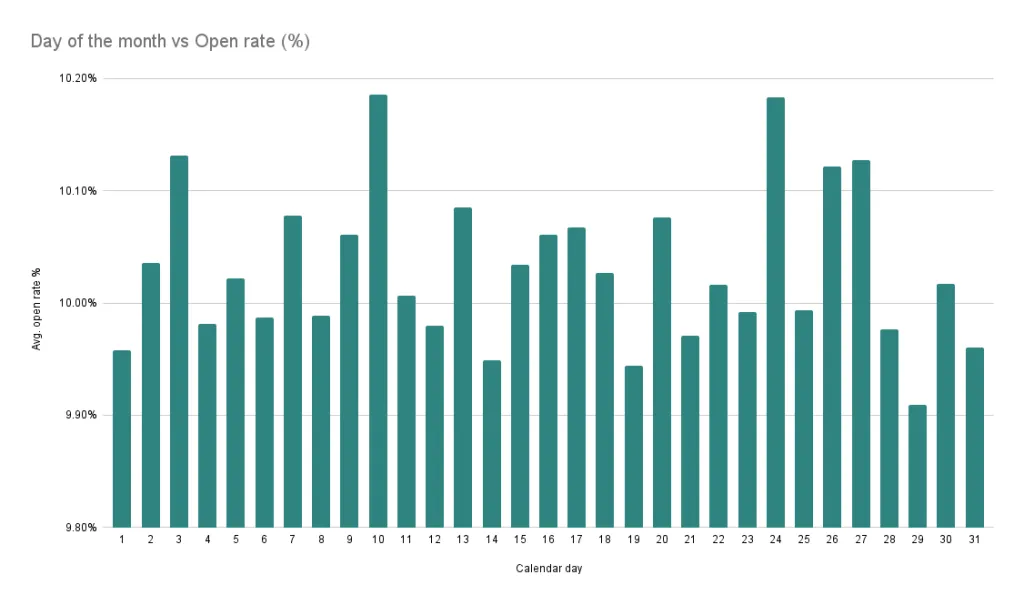
👉 Related content: How often you should send marketing emails
3. Write brief and compelling subject lines
Category: Content
Email subject lines are the first thing anyone sees when they open their inbox. Therefore, it’s a crucial email marketing best practice to optimize it.
You want to capture your recipients’ attention from the get-go by making your subject lines engaging, informative, and succinct.
Here are some tips to write compelling email subject lines:
- Get the length right: The recommended length is 30 to 50 characters. Anything longer could get cut off.
- Use the recipient’s name: This makes your email sound personalized, which captures your reader’s attention.
- Mention discounts: While this will intrigue your prospect, be sure not to sound too salesy.
- Use numbers: Where possible quote percentages, discount prices, etc.
- Add some emojis: Create a light-hearted mood with your emails by including a few emojis in your subject lines.
- Try limited-time offers: This creates a sense of urgency in customers pushing them to make a purchase.
- Use power words: Words like “exclusive”, “giveaway”, and “instantly” make your emails more persuasive.
Here’s an example.

Want to learn how your subject lines compare to the best practices?
👉 Free subject line tester
Related content:
• 105 best email subject lines
• 68 catchy email subject lines
• High converting subject lines
• Welcome email subject lines
• Emojis in subject lines
4. Add a preview text
Category: Content
The preview text is the next thing a person would see after reading your subject line in their inbox. Usually, it’s pulled from the first few words of your email body.
Optimizing your preview text is a good email marketing best practice as it’s your second chance to convince a recipient to open your email. Therefore, you’ll need to make it cohesive and just as compelling as your subject line, if not more.
Here’s how:
- With display limits of 90 characters in mind, make your preview text 35 to 50 characters long.
- Personalize your preview text by including names or other relevant details, especially if you haven’t in your subject line.
- If your tool provides an email preheader section, use it to write your preview text.
- Avoid repeating what’s already included in your subject line.
- Use action words as much as you can.
- A/B test your preview texts and identify what works well with your audience.
Example:

👉 Related content: Email preheader guide
5. Keep email copy short and simple
Category: Content
Email is a versatile medium, but it’s not the place for long, narrative prose. Capture people’s attention and keep it by using short, concise paragraphs only.
Although email copy length is relative, anything between 50 to 125 words is ideal. This may sound too brief, but less is always more when it comes to emails.
Here are some email marketing best practices to keep in mind, when it comes to email length:
- Keep important elements above the fold: This goes for your main message and call-to-action so your users won’t have to scroll down to get to the heart of it.
- Use bullet points: This helps you keep lengthier emails more organized and scannable.
- Run A/B tests: Test your short and long email variants to identify what works best for your business.
Choose a reliable app to implement the best practices of email marketing:💡 Best email marketing software
6. Make irresistible CTA buttons
Category: Content
CTA buttons convince your readers to take action, telling them exactly what to do. They emphasize the purpose of your email, which could be attracting store visits, promoting ongoing offers or sales, offering discounts, etc.
CTAs are how you lead your customers in the right direction, which makes them essential for email marketing.
Examples include “notify me”, “shop new arrivals”, “try free”, “order” etc. Here are some email marketing best practices for optimizing your CTAs:
- Contrast: Make your CTA button different in color, size, font, etc, so it stands out from the rest of your email content. This also makes it easy to spot.
- Length: Keep the text on your CTA button brief and to the point. Ideally, it shouldn’t be longer than 5 words.
- Action-oriented: It goes without saying that your call-to-action should contain an action word, such as try, shop, notify, get, etc.
Example:
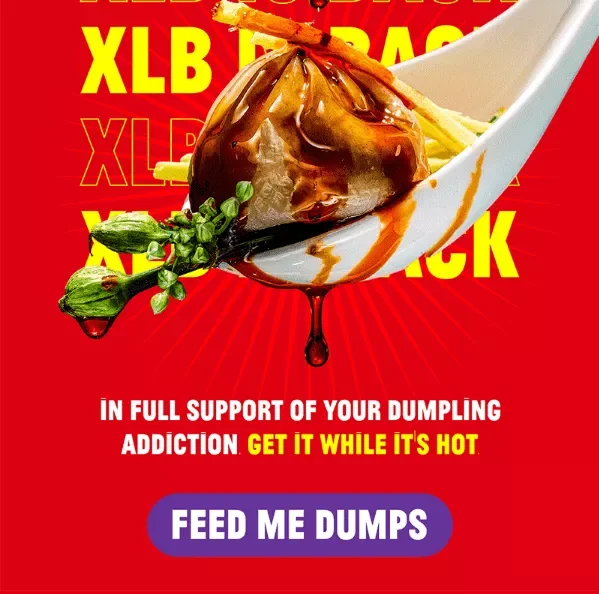
👉 Related content: How to create powerful CTAs that work
7. Send welcome emails
Category: Strategy
With 8 out of 10 customers now coming to expect a welcome email, making a great first impression has never been so important.
You want your onboarding emails to showcase your brand’s personality and ultimately convince your subscribers to buy what you’re selling. That’s why, you need to ensure your welcome emails are unique and authentic.
Here are email marketing best practices to help you create the best welcome emails:
- Introduce your brand: Establish your relationship with your reader by telling them who you are and what your brand is all about.
- Include offers or discounts: As a welcome gesture, you can offer an incentive in form of a discount or a special offer to your email recipient.
- Set your brand apart: Offer a unique selling point to set your brand apart, for instance, shipping speed, return policy, etc.
- Use social proof: This helps create trust in your prospective customers and boost your brand’s credibility.
Here’s a welcome email template example for your inspiration.

Related content:
• Welcome email series: tips & best practices
• Welcome email subject lines
8. Educate your subscribers
Category: Content
Your email marketing efforts should go beyond just selling to your customers. You need to educate your audience about your products and provide relevant information that can help them on a day-to-day basis.
Help your audience make the most of the products they buy from you by sharing tips and providing links to relevant resources on your website, social media, and so on.
Here are some best practices to help you create more educational emails for your audience:
- Use instructions: Include brief instructions in your email and link back to more detailed resources on your website for further reading.
- Include images: Since educational emails can be lengthy, break the monotony by including several images in your emails.
- Create an educational series: Segment your contact list and create an educational email series for a more interested audience.
Here’s an educational email marketing example.
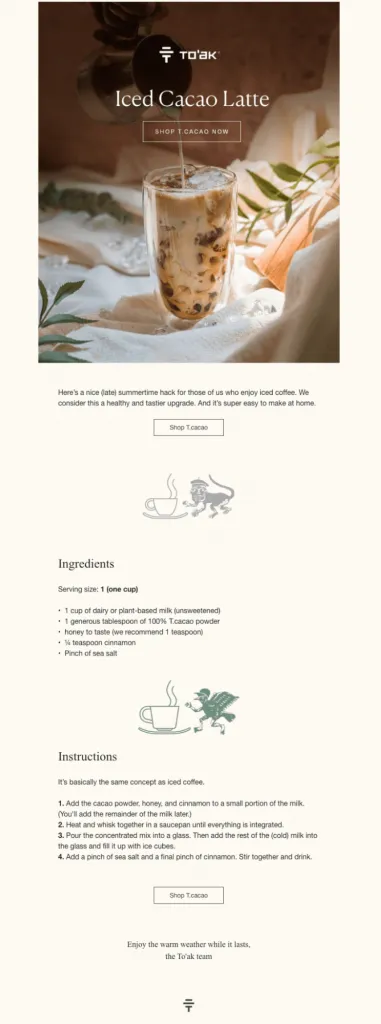
Related content:
• Newsletter templates and examples
• Email design templates
9. Write captivating stories
Category: Content
Do you have a story to tell?
An interesting, engaging narrative about your business can create an emotional attachment with your customers and inspire real meaning in your brand.
Emails give you enough room for expression and creative visual design, making them one of the best channels for this kind of marketing.
Here are some best practices to ensure your brand story is captivating:
- Share sneak peeks: Show what’s happening “behind the scene”, and how your products are being crafted (best for D2C businesses)
- Use high-quality images: Share clear pictures of products in their natural habitat.
- Involve real customers: Use images of happy people using your products and include reviews with customers’ faces.
- Introduce your brand and CEO: Share a video describing your brand and include a photo of your CEO with his/her quote.
Here’s how Amundsen Sports uses storytelling as part of its email marketing strategy to increase revenue.

And this is their website for the same campaign:
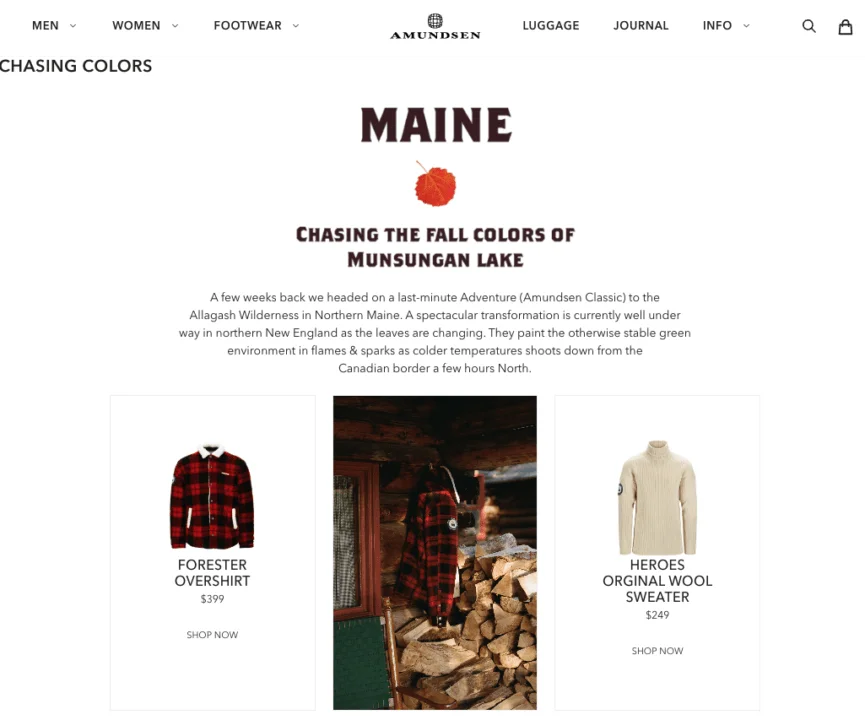
10. Use social proof
Category: Strategy
This is another of the top email marketing best practices to help improve your click-through rates.
People are more likely to buy products that other people have bought and approved of compared to those that aren’t as popular.
Types of social proof you can use in your email marketing campaigns include:
- Product reviews: Including reviews from real customers encourages your audience to click on CTAs in your email and visit your site.
- Customer testimonials: This helps raise your conversion rates by showcasing your customers’ love for your products.
- Press mentions: If you’ve had your brand mentioned by popular media outlets or publications, it adds to your authority and credibility.
- Usage numbers: Showcasing statistics, such as the number of people using your products, triggers FOMO (fear of missing out) in your prospects.
- Awards received: Include any industry awards your business has received, especially those with high credibility in your industry.
Example:

Related content:
• Social commerce to unlock customer loyalty
• 7 tips on how to create a captivating product review email [+examples]
11. Tailor emails according to subscriber activity
Category: Strategy
The most effective emails are those that reach out to the right person at the right time and with the right message even for your email blasts.
Therefore, tailoring your communication according to subscriber activity is essential if you want to maximize your ecommerce marketing activities.
Here are a few ideas on how you can adopt this practice in your email communication flow:
- Send a welcome email series when a subscriber signs up
- Send a cart abandonment email when a subscriber abandons the checkout
- Send a thank you email to loyal customers when they buy from you repeatedly, for example, after the 3rd, 8th, 15th orders. Include a small gift voucher or something else to please them
- Send a reactivation email if your subscribers don’t open your emails for a while.
Example:
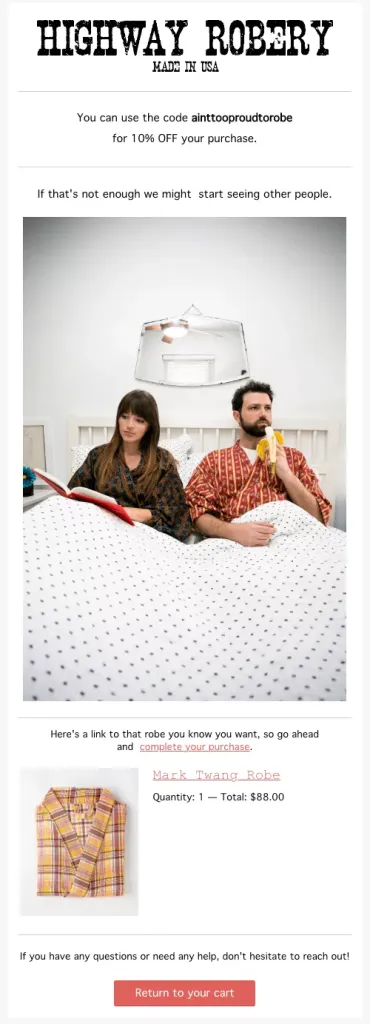
👉 Related content: Reasons shoppers leave without buying [+solutions]
12. Make your subscribers feel appreciated
Category: Strategy
While it’s okay to build your contact list by seeking new subscribers, retaining the existing ones is easier. An easy way to do that is by making your readers feel valued.
Showing appreciation for your customers also helps build loyalty. Here are some ideas on how to achieve this:
- Exclusive offers: Create exclusive offers based on a customer’s activity, e.g a discount for the first 5 purchases, etc.
- First access to products: This works best for limited offers. Give your loyal customers special access to your sales before making it public.
- Thank-you emails: Avoid generic thank-you emails by showcasing your brand’s personality.
- Birthday emails: Make your customers feel valued by sending birthday emails, along with an offer or discount.
- Loyalty program: You can offer loyalty points for every purchase that’s redeemable either for a gift card or money etc.
Example:
Beardbrand gives their subscribers early access to popular products:
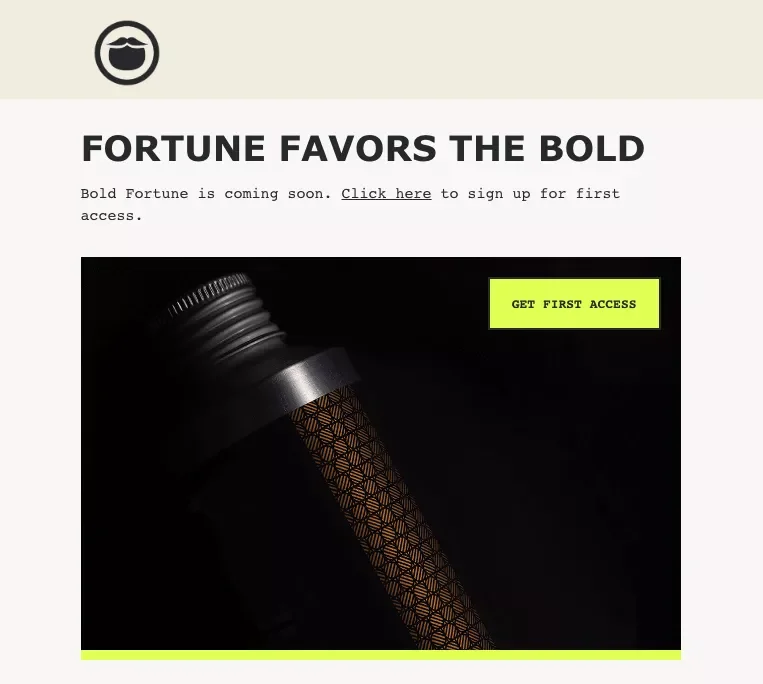
Here’s an example from Vessi that does the same:
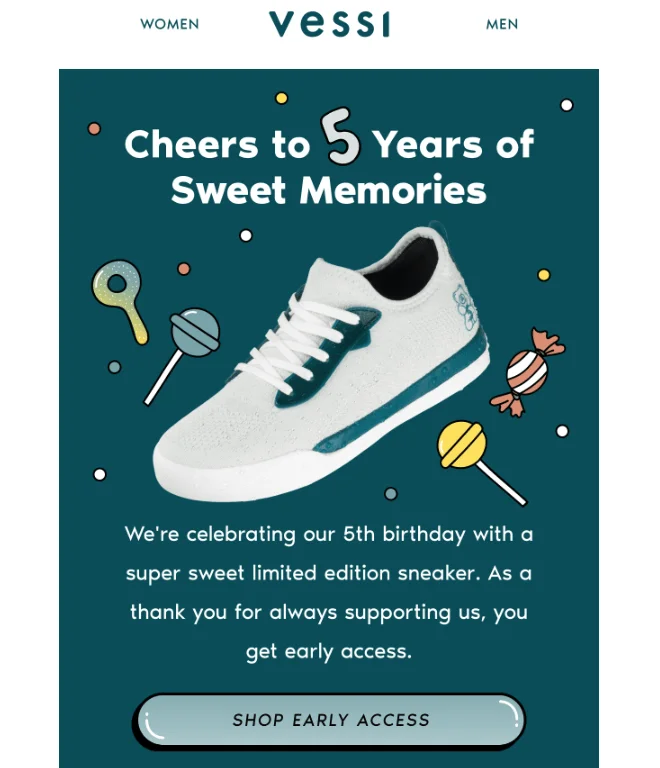
Related content:
• 12 thank-you email templates & examples for ecommerce
• 10 businesses with the best loyalty programs
• Birthday emails: Tips and best practices to increase sales
13. Add social media content and buttons
Category: Content
Embedding your social media posts into your email marketing campaigns boosts engagement.
You’ll be showing your audience a different side of your brand if you introduce them to your social media posts.
Here’s what combining social media with email marketing can help you achieve:
- You’ll stand out: It adds more visual appeal to your email marketing campaigns helping you attract more attention and make your emails stand out.
- Boosts engagement: Your visitors will be able to easily share, like, or comment on your embedded social media posts
- Social proof: Social media posts are great for sharing customer testimonials with your email marketing audience.
- Increases your availability: You’ll be showing your subscribers that they can contact you through other channels besides email.
Example

Related content:
• How to integrate social media into your email campaigns
• How to use email campaigns to collect user-generated content for your brand
14. Design simple, scannable emails
Category: Design
People seldom read promotional emails nowadays, who has the time? Usually, we quickly skim them for clear signs of interest, before clicking away.
With this in mind, a clear email structure that highlights your most vital information is important for getting your message across.
Pay attention to the following best practices when designing your email:
- Keep the design simple: Only emails of up to three columns look good on mobile devices
- Limit your content: Keep emails short. Otherwise, your newsletter will be endless for mobile readers, as all the content lays down into one narrow column. No one will bother to scroll your email to get to the end.
- Avoid asymmetric designs: In most cases, they are not mobile-friendly.
- Define your sections: If your email highlights different types of content, clearly define sections by using spacing and lines. So it would be easier to skim it.
Take this email template, for example. It has a simple, symmetrical design that highlights the main CTA.

👉 Related content: Responsive email quick guide: Your gateway to better email campaigns
15. Be consistent with your campaigns
Category: Strategy
Another strategy that made it to this email marketing best practices list is being consistent with your emails. Consistency in both frequency and timing makes your business feel more credible.
As a best practice, it’s a good way of keeping track of your email marketing performance. You’ll be able to track your engagement rates, and spot which periods/times have the highest conversion rates.
These tips will help with your consistency:
- Schedule your emails: Stick to a specific time, for instance, you can send out your email newsletters weekly, biweekly, monthly, etc, so your audience can expect them in their inboxes.
- Plan ahead: Plan your content ahead of time so that when your scheduled time comes, you’re not rushing to create fresh content.
- Recurring schedule: Create a schedule for seasonal sales, like Black Friday, Labor Day, New Years, etc.
- Follow-up emails: Send follow-up emails to people who don’t open the initial ones you send.
Here’s an example showing consistency in email campaigns.
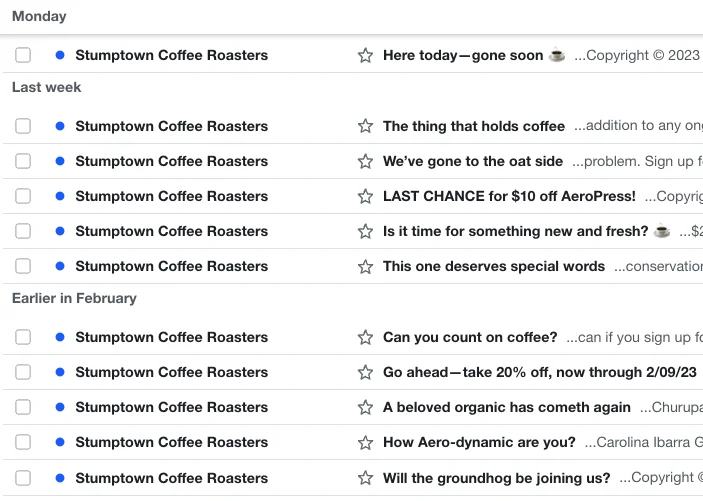
16. Automate repetitive campaigns
Category: Strategy
Email automation is a must-have for any serious marketer in this day and age. It’s best practice to ensure your email marketing tool has robust automation features.
Here’s why:
- Clear goals: You don’t need to think too much about what to say in your emails. Every automated workflow has a clear goal that helps to define the copy and the content itself.
- Personalization: Automated content is always relevant because it’s personalized. Customers always find the information they expect from you.
- Optimized timing: You don’t need to guess what’s the best time to send your emails. Automated emails have the best timing possible based on complex algorithms.
- Save time: You only need to set up the workflows, then they’ll do the work for you, 24 hours a day.
Example of re-engagement (win-back) email (that could also be automated):
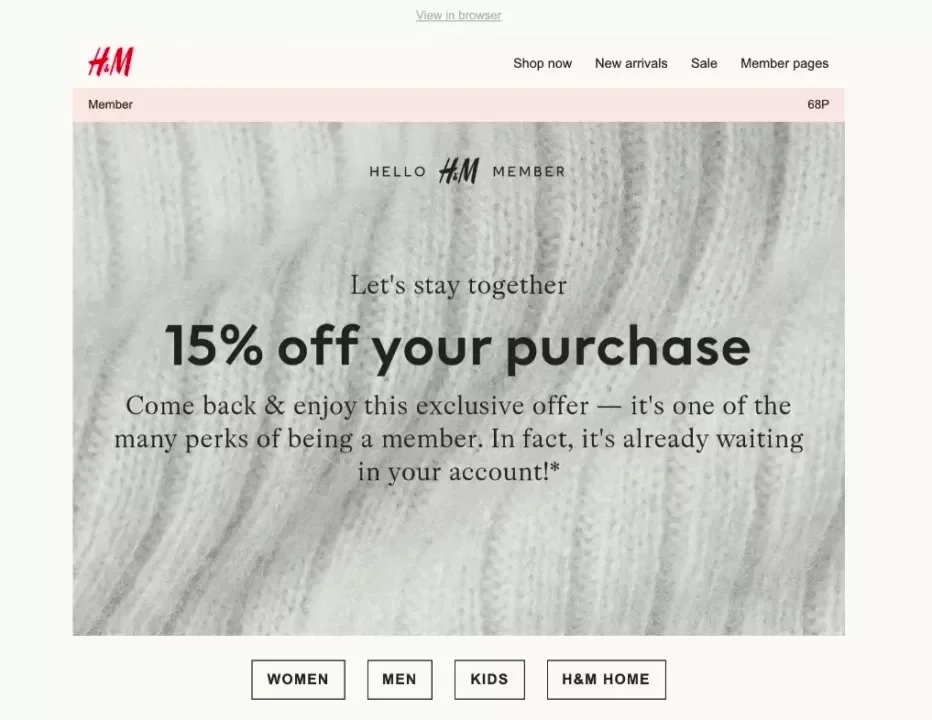
Related content:
• Email automation: definition, benefits, and tools
• 10 marketing automation workflow examples and tips
17. Track engagement with clickmaps
Category: Strategy
A clickmap in email marketing is a visual representation of your engagement data. It shows you the buttons, links, products, etc. that your customers clicked on in your newsletter.
It’s a good practice to have an email marketing tool with a clickmap reporting feature to help you monitor your customer’s preferences.
Take Omnisend’s Clickmap feature, for instance. All you’ll need to do is head over to your Reports section and click on the newsletter you want to view. Your click rates (if any) will show on your reports in percentages like below.

You can then click on the View Clickmap button for a more detailed visual on the distribution of your clicks on your newsletter.
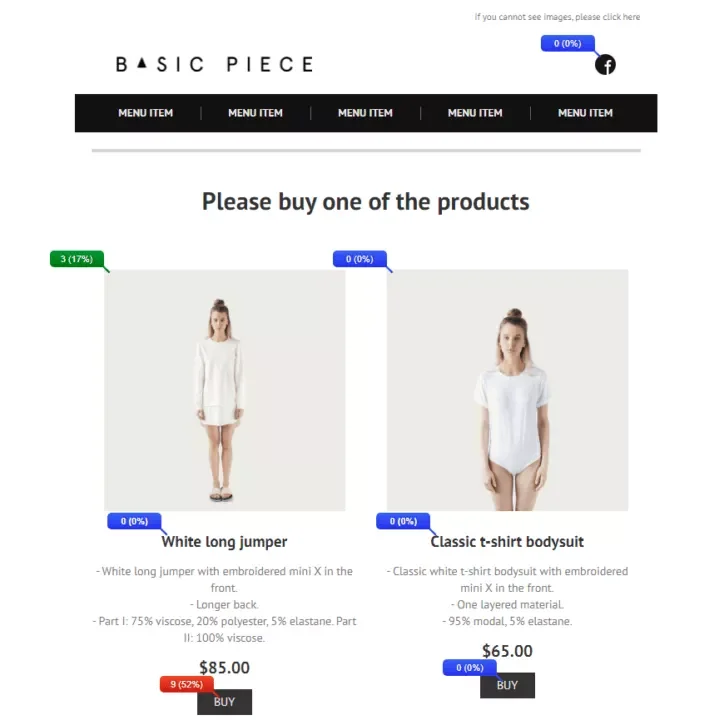
Then, view the distribution of your clicks and see what your audience engaged with the most.
Here’s more information on how Omnisend’s Clickmap works.
18. Add unsubscribe and content preference buttons to footers
Category: Design
One of the important email marketing best practices is to give your audience the liberty to opt out of your emails easily. Or better yet, let them choose the content they’d like to receive.
In the long run, it’s good for your business if inactive or uninterested subscribers leave. So make those two prompts available on your email footers.
Here’s what not to do while at it:
- Hiding the unsubscribe link: Ensure that the unsubscribe button or link is easy to spot, i.e. use a different color, bold, etc.
- Make it easy: Avoid long unsubscription procedures like asking customers to send you an email.
- Asking for feedback before they unsubscribe: You can ask for feedback from your prospects, but only after you let them unsubscribe.
Opt-in marketing is about customers giving or denying you permission to reach them.
Example:

👉 Related content: Why marketers should embrace unsubscribe button
19. Use analytics to track email performance
Category: Strategy
Analytics helps you make data-driven email marketing decisions based on your performance metrics. It’s therefore one of the most effective email marketing best practices to track your campaign performance.
Make sure you have a tool that tracks your engagements, monitors your performance, and produces useful insights. These insights should be in the form of attractive visuals that are easy to interpret too.
Here are somebest practices to help you make the most of your analytics:
- Compare your analytics with industry benchmarks and see how your performance compares.
- Choose the metrics that are the most important for your marketing campaigns and track them regularly.
- Avoid overanalyzing your metrics and their importance and focus on the improvements in your campaign performance.
Here’s an example of a performance analytics dashboard.
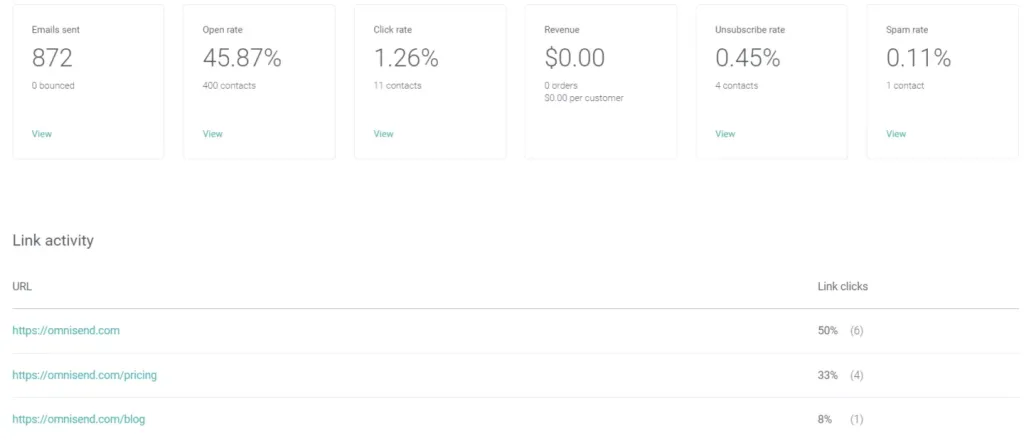
Tips to improve engagement rates:
• How to measure email marketing campaign performance
• Post-purchase messaging for first-time customers
• Improve customer retention with lifecycle-based segmentation
• 11 customer retention strategies that actually work
20. Keep your email list clean
Category: Strategy
Keeping your list clean means that you approach only those subscribers who are signed up for your newsletter and are still engaged with your brand — these are the people who bring community and value!
Having a long list of contacts may seem impressive, but if they’re inactive, that only hurts your bottom line.
Here are some email list cleaning best practices to keep in mind:
- Review your email list every six months, or three if you want your list uber clean. Don’t wait more than a year though, as that’d be too long.
- Engage people in your inactive list with further campaigns or ask them if they want to remain on your list.
- Remove subscribers who are still inactive after re-engagement.
- Last but not least, segment your inactive contacts to make your email list management easier. You can decide to isolate them for further engagement or removal.
21. Monitor deliverability
Category: Strategy
Sometimes, your emails don’t reach your prospect’s inbox due to numerous reasons.
Therefore, as one of the important email marketing best practices, you need to make sure they get delivered and don’t end up in the spam folder.
The factors that impact your email deliverability can either be within your control or not. But you can sure take steps to improve your email deliverability.
Here are some factors to boost your email deliverability:
- Don’t be overly promotional: Avoid overusing spam words like “free” in your subject lines.
- Clean your list: Check your contact list regularly for emails that are no longer in use.
- Monitor your email volume: Monitor the volume of newsletters you send, as high volumes could be mistaken for spam. Also, have a predictable pattern with the number of emails you send.
- Mobile-friendly designs: Use simple design templates so your emails load properly on your recipient’s mobile device
Related content:
• How 123Presets improved their deliverability & doubled their revenue
• How to use sender reputation warming for better email deliverability
• Email content for better deliverability
Email marketing best practices: takeaways
The list may seem long, but there are endless benefits to maintaining the discussed email marketing best practices. You’ll be able to increase your engagement, improve the quality of your email list, raise your conversion rates, and much more.
You don’t even need to be an email marketing veteran to get it right. Each item is easy to put into practice, and you’ll get used to it in no time.
Source from Omnisend
Disclaimer: The information set forth above is provided by omnisend.com independently of Alibaba.com. Alibaba.com makes no representation and warranties as to the quality and reliability of the seller and products. Alibaba.com expressly disclaims any liability for breaches pertaining to the copyright of content.



